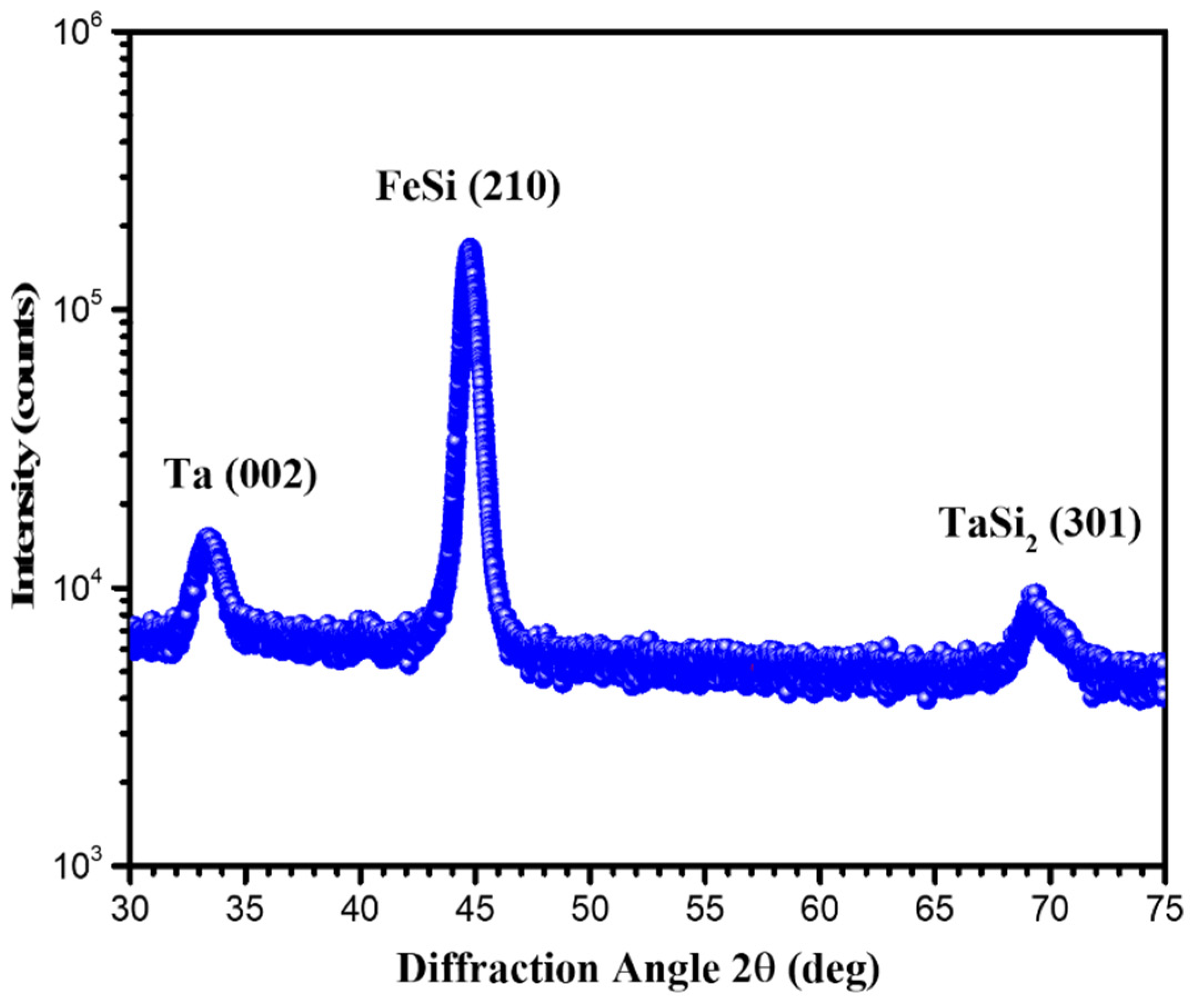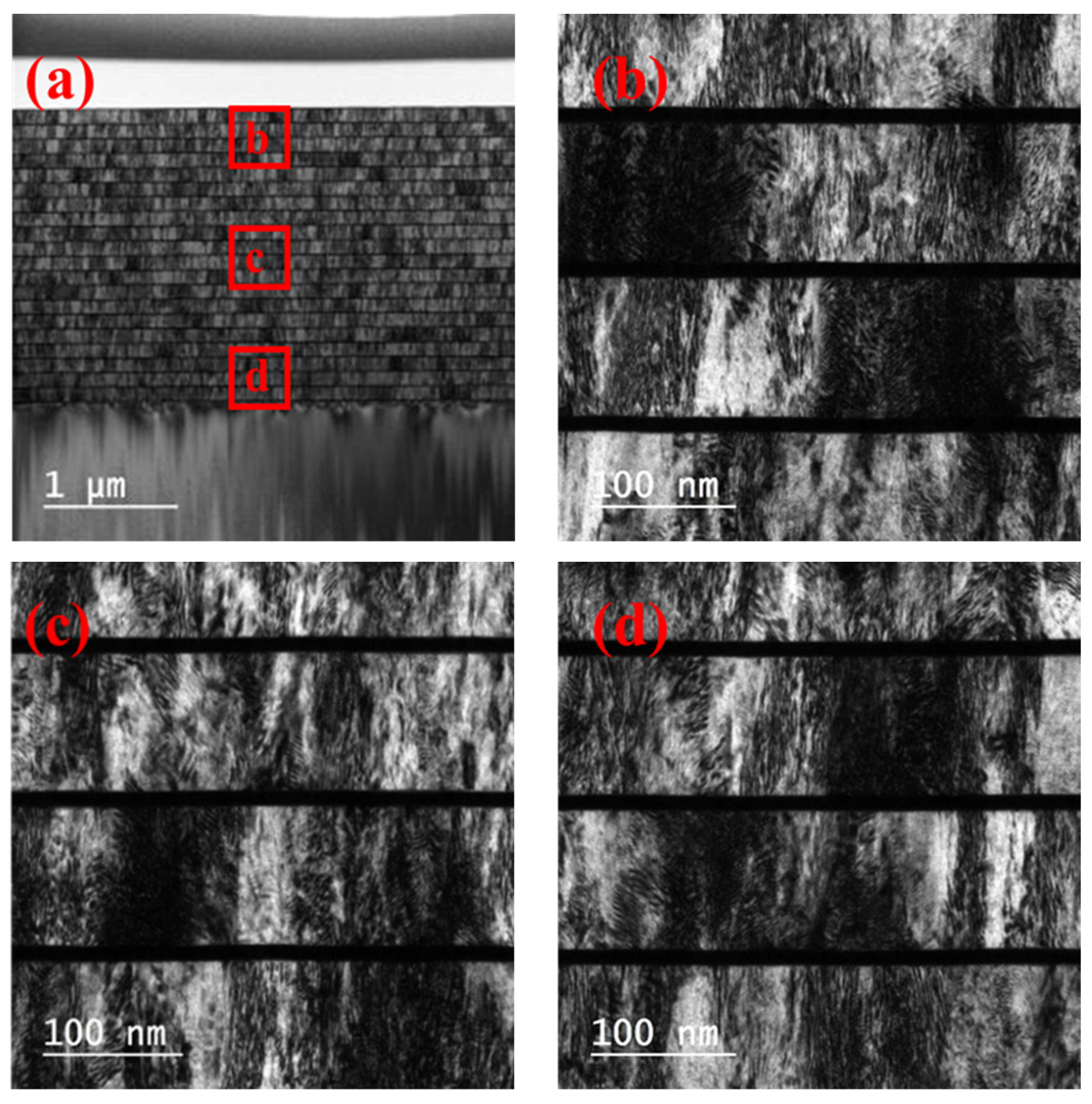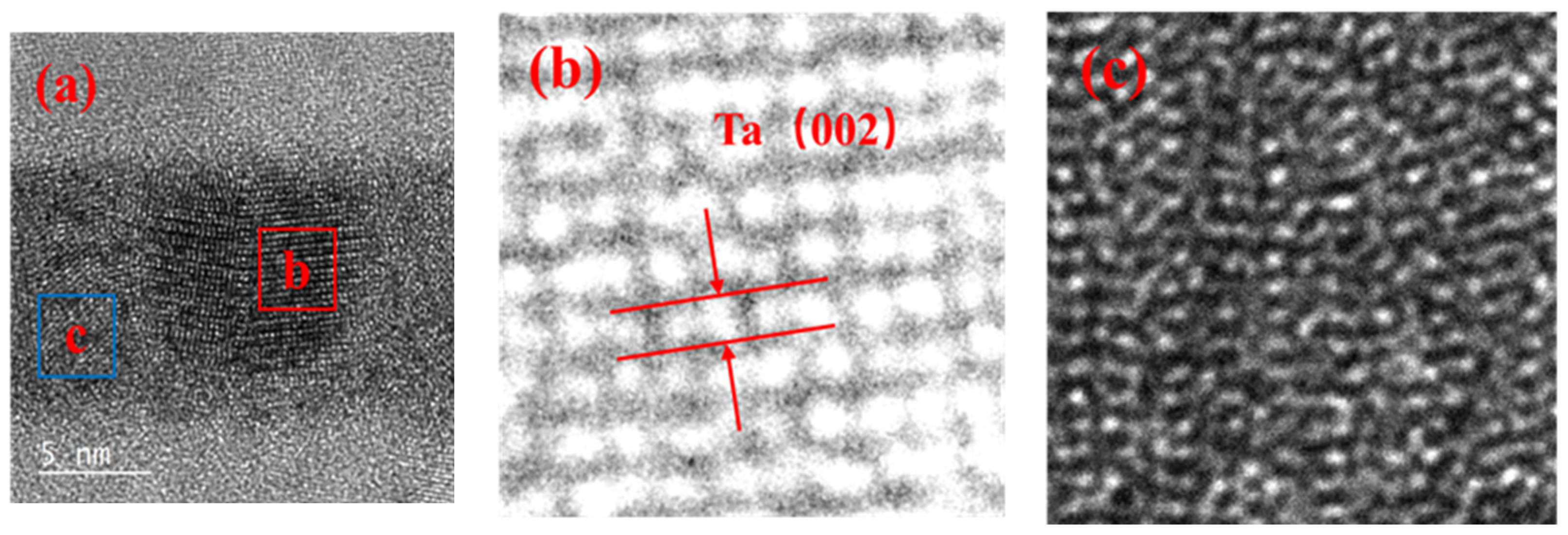Effect of Ta Interlayers on Texture and Magnetic Properties of FeSi Films with Micrometer Thickness
Abstract
:1. Introduction
2. Materials and Methods
3. Results and Discussion
3.1. Hysteresis Loop Measurement
3.2. X-ray Diffraction Measurement
3.3. High Resolution Transmission Electron Microscopy
4. Conclusions
Author Contributions
Funding
Institutional Review Board Statement
Informed Consent Statement
Data Availability Statement
Acknowledgments
Conflicts of Interest
References
- Seemann, K.; Leiste, H.; Ziebert, C. Soft magnetic FeCoTaN film cores for new high-frequency CMOS compatible micro-inductors. J. Magn. Magn. Mater. 2007, 316, e879–e882. [Google Scholar] [CrossRef]
- Herzer, G.; Vazquez, M.; Knobel, M.; Zhukov, A.; Reininger, T.; Davies, H.A.; Grössinger, R.; Sanchez, J.L. Round table discussion: Present and future applications of nanocrystalline magnetic materials. J. Magn. Magn. Mater. 2005, 294, 252–266. [Google Scholar] [CrossRef]
- Muraca, D.; Silveyra, J.; Pagnola, M.; Cremaschi, V. Nanocrystals magnetic contribution to FINEMET-type soft magnetic materials with Ge addition. J. Magn. Magn. Mater. 2009, 321, 3640–3645. [Google Scholar] [CrossRef]
- Tashiro, T.Y.; Mizuguchi, M.; Kojima, T.; Koganezawa, T.; Takanashi, K. Structural and magnetic properties of FeNi thin films fabricated on amorphous substrates. J. Appl. Phys. 2015, 117, 4423. [Google Scholar] [CrossRef]
- Svalov, V.A.; LarrañAga, A.; Kurlyandskaya, V.G. Effect of Ti seed and spacer layers on structure and magnetic properties of FeNi thin films and FeNi-based multilayers. Mater. Sci. Eng. B 2014, 188, 102–105. [Google Scholar] [CrossRef]
- Cheng, S.F.; Lubitz, P.; Zheng, Y.; Edelstein, A.S. Effects of spacer layer on growth, stress and magnetic properties of sputtered permalloy film. J. Magn. Magn. Mater. 2004, 282, 109–114. [Google Scholar] [CrossRef]
- Choi, J.G.; Hwang, D.G.; Rhee, J.R.; Lee, S.S. Comparison of the soft magnetic properties of permalloy and conetic thin films. J. Magn. Magn. Mater. 2010, 322, 2191–2194. [Google Scholar] [CrossRef]
- Galtier, P.; Jerome, R.; Valet, T. Texture and grain size of permalloy thin films sputtered on silicon with Cr, Ta and SiO2 buffer layers. MRS Online Proc. Libr. 1994, 343, 417–422. [Google Scholar] [CrossRef]
- Sato Turtelli, R.; Penton-Madrigal, A.; Barbatti, C.F.; Barbatti, C.F.; Grössinger, R.; Sassik, H.; Estevez-Rams, E.; Sarthour, R.S.; Sinnecker, E.H.C.P.; Guimarães, A.P. Effect of the addition of Cr, Ta and Nb on structural and magnetic properties of Fe–Si alloys. J. Magn. Magn. Mater. 2005, 294, e151–e154. [Google Scholar] [CrossRef]
- Inoue, A.; Kong, F.; Han, Y.; Zhu, S.; Churyumov, A.; Shalaan, E.; Al-Marzouki, F. Development and application of Fe-based soft magnetic bulk metallic glassy inductors. J. Alloys Compd. 2018, 731, 1303–1309. [Google Scholar] [CrossRef]
- Han, Y.; Kong, F.; Han, F.; Inoue, A.; Zhu, S.; Shalaan, E.; Al-Marzouki, F. New Fe-based soft magnetic amorphous alloys with high saturation magnetization and good corrosion resistance for dust core application. Intermetallics 2016, 76, 18–25. [Google Scholar] [CrossRef]
- Xie, L.; Liu, T.; He, A.; Li, Q.; Gao, Z.; Wang, A.; Chang, C.; Wang, X.; Liu, C. High Bs Fe-based nanocrystalline alloy with high impurity tolerance. J. Mater. Sci. 2018, 53, 1437–1446. [Google Scholar] [CrossRef]
- Zhang, H.; Song, L.; Xu, W.; Huo, J.; Wang, J.-Q. Correlations between the thermal properties and the electronegativity of soft magnetic Fe-based amorphous alloys. Intermetallics 2019, 108, 61–65. [Google Scholar] [CrossRef]
- Xi, L.; Sun, Q.J.; Li, X.Y.; Zhou, J.J.; Du, J.H.; Ma, J.H.; Wang, Z.; Shi, X.N.; Zuo, Y.L.; Xue, D.S. Recovery of soft magnetic properties of FeNiSm films by Ta interlayer. J. Magn. Magn. Mater. 2011, 323, 2219–2223. [Google Scholar] [CrossRef]
- Svalov, A.V.; Fernandez, E.; Garcia-Arribas, A.; Alonso, J.; Fdez-Gubieda, M.L.; Kurlyandskaya, G.V. FeNi-based magnetoimpedance multilayers: Tailoring of the softness by magnetic spacers. Appl. Phys. Lett. 2012, 100, 033902. [Google Scholar] [CrossRef]
- Wu, Z.Y.; Xian, C.; Jia, J.X.; Liao, X.W.; Kong, H.; Wang, X.S.; Xu, K. Silica coating of Fe-6.5 wt%Si particles using fluidized bed CVD: Effect of precursor concentration on core–shell structure. J. Phys. Chem. Solids 2002, 146, 109626. [Google Scholar] [CrossRef]
- Shokrollahi, H. The magnetic and structural properties of the most important alloys of iron produced by mechanical alloying. Mater. Des. 2009, 30, 3374–3387. [Google Scholar] [CrossRef]
- Yaegashi, S.; Kurihara, T.; Satoh, K. Preparation and soft magnetic properties of epitaxial Fe–Si(111) monolayer films and Fe–Si(111)/Cr(111) multilayer films. J. Appl. Phys. 1997, 81, 6303–6309. [Google Scholar] [CrossRef]
- He, J.L.; Zhang, Z.; Bao, Z.H.; Sun, G.A.; Li, X.X.; Wang, S.Q.; Wang, Z.S. Magnetized FeSi film with micrometer thickness inserted with Cr layers as π-flippers for neutron spin-echo spectrometry. Nucl. Instrum. Methods Phys. Res. A 2022, 1042, 167457. [Google Scholar] [CrossRef]





Publisher’s Note: MDPI stays neutral with regard to jurisdictional claims in published maps and institutional affiliations. |
© 2022 by the authors. Licensee MDPI, Basel, Switzerland. This article is an open access article distributed under the terms and conditions of the Creative Commons Attribution (CC BY) license (https://creativecommons.org/licenses/by/4.0/).
Share and Cite
He, J.; Zhang, Z.; Bao, Z.; Sun, G.; Li, X.; Qiu, X.; Wang, S.; Wang, Z.; Huang, Q.; Yi, S. Effect of Ta Interlayers on Texture and Magnetic Properties of FeSi Films with Micrometer Thickness. Materials 2022, 15, 6789. https://doi.org/10.3390/ma15196789
He J, Zhang Z, Bao Z, Sun G, Li X, Qiu X, Wang S, Wang Z, Huang Q, Yi S. Effect of Ta Interlayers on Texture and Magnetic Properties of FeSi Films with Micrometer Thickness. Materials. 2022; 15(19):6789. https://doi.org/10.3390/ma15196789
Chicago/Turabian StyleHe, Jialian, Zhong Zhang, Zhihao Bao, Guangai Sun, Xinxi Li, Xuepeng Qiu, Shiqiang Wang, Zhanshan Wang, Qiushi Huang, and Shengzhen Yi. 2022. "Effect of Ta Interlayers on Texture and Magnetic Properties of FeSi Films with Micrometer Thickness" Materials 15, no. 19: 6789. https://doi.org/10.3390/ma15196789
APA StyleHe, J., Zhang, Z., Bao, Z., Sun, G., Li, X., Qiu, X., Wang, S., Wang, Z., Huang, Q., & Yi, S. (2022). Effect of Ta Interlayers on Texture and Magnetic Properties of FeSi Films with Micrometer Thickness. Materials, 15(19), 6789. https://doi.org/10.3390/ma15196789







